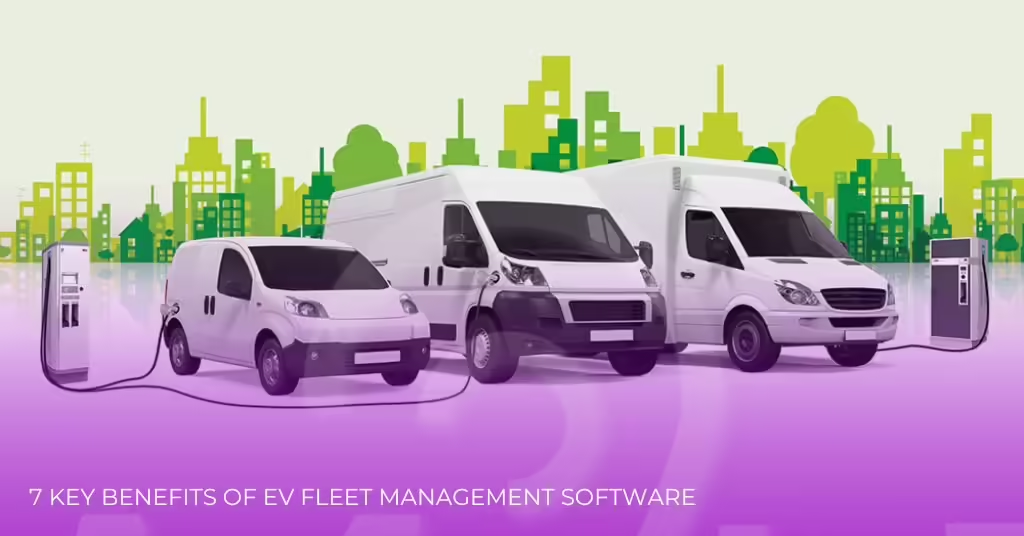What Are the Benefits of EV Fleet Management Software?
Learn seven key benefits of EV fleet management software (EVFMS). Connect with Mile today to integrate your EV fleet with our specialized solution.
The electric vehicle (EV) era has officially begun and brought with it a paradigm shift in the transportation sector. Despite high upfront costs, switching to EVs is now more feasible than ever. Also, compared to the cost of fueling a traditional gas-powered vehicle, charging an EV is relatively cheaper and more eco-friendly.
As climate change and environmental problems get more public attention, a rising number of logistics operators are considering fleet electrification as part of their sustainable corporate strategy. Internal combustion engine (ICE) vehicle bans are also in the works in several countries, meaning that businesses will have to start transitioning to EVs sooner or later.
Having said that, an EV fleet can be just as difficult to manage as any other type of fleet. At this point, fleet management software specialized for electric vehicles becomes the most relevant.
7 Key Benefits of EV Fleet Management Software (EVFMS)
If switching your fleet to EVs has been on your mind lately, we’ve outlined seven key benefits of an EV fleet management software below to help you decide quickly and confidently.
1: Real-Time Vehicle Tracking
This is one of the most important features of an EVFMS because it gives fleet managers the ability to see exactly where their vehicles are at any given moment. They can also monitor an EV’s charging levels, predicted range, battery life, and depreciation in real time. If there’s an unexpected problem with the charging of a vehicle, the software triggers a notification to the driver, so they don’t have to deal with a depleted battery first thing in the morning.
2: Advanced EV Route Planning
The amount of distance a vehicle can travel depends largely on its battery’s capacity and usage. First, an EVFMS uses available telemetry and third-party data to estimate the energy consumption for various vehicle types and delivery routes. Then it analyzes aspects like traffic, topography, and weather conditions to map out the most optimal journey plan possible.
3: Charging Schedules
Making sure all electric vehicles are fully charged and operational is always a top priority for fleet managers. Using EVFMS’s advanced charging management tools, they can plan optimal charging schedules for times when electricity is less expensive, such as during off-peak hours. Some softwares also provide managers with remote access, allowing them to start or stop charging based on immediate needs or changes in the energy grid.
4: Recharging Module
When recharging is necessary, the trip planner automatically includes the nearest and fastest charging stations. The driver can see the expected arrival and charging times for each station and detour accordingly. Besides using topological data to modify the charge forecast, the software updates the estimated time of arrival (ETA) in response to any driver diversions. The vehicle’s battery, too, begins to heat up as soon as the driver gets close to the charging station. This improves charging quality and shortens charging time.
5: Range Prediction Module
An EV’s range is directly related to the performance it delivers during its lifetime. A good EVFMS uses AI-powered data analytics and ML algorithms to accurately estimate the driving range of an EV.
Range prediction depends on a number of factors like:
- Vehicle design
- Vehicle speed
- Battery charge level
- Driving patterns
- Route conditions
- Weather
- Terrain
The software collects all this data and processes it to predict how far a vehicle can travel without needing to stop for recharging or switch to optimal driving practices (turning off the A.C, driving at a low speed, etc.). It also continuously refines its predictions based on new data and driving patterns.
6: Timely Maintenance
Although EVs require far less maintenance than regular vehicles, it’s always good practice to keep an eye out for wear and tear. An EVFMS analyzes vehicle usage trends and maintenance history logs and sends out predictive maintenance alerts to ensure managers schedule maintenance services on time and help avoid sudden breakdowns on the road.
7: Driver Behavior Management
With EVFMS, you can detect if a certain driver drives too fast on a regular basis or applies the brakes too forcefully. To encourage a safety culture, you can reward good driving habits and penalize recklessness. Knowing there are incentives for driving safely, your delivery personnel will act responsibly on the road, saving you a lot of money on brake repairs, realignments, and more!
Miscellaneous Benefits
Other than the benefits listed above, electric vehicle fleet management software also gives you actionable insights that you can use to plan better dispatch schedules, provide more accurate ETAs, and flag vehicles that leave authorized geofences without prior intimation.
With a network of charging stations, you can monitor individual charging stations’ availability, usage, and offline status in real time. Apart from that, you can automate a number of charging processes, such as:
- Scheduling vehicles that have just returned from a charging journey;
- Prioritizing fast charging for vehicles that are in rotation;
- Queuing vehicles that are not in rotation for off-peak charging when energy prices are lower; and
- Gathering charging data from all vehicles to improve charging schedules.
You can also use the reporting and analytics feature of an EVFMS to generate thorough reports on your fleet’s performance, charging usage, energy consumption, cost per trip, etc. Some EVFMSs come with native merchant and driver apps to streamline both order management and delivery cycles. They even have restful APIs that integrate with existing workflows to streamline payments, accounting, and payroll.
Looking for an EVFMS for your fleet? Let’s talk.

